Archive for January 18, 2010
Cage Variations
January 18, 2010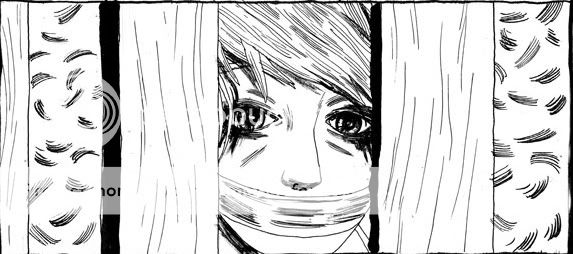
Over at Matt Rota’s site you can read “We Had No Idea,” our latest comic together. I hope you enjoy it!
Comics Time: Forming
January 18, 2010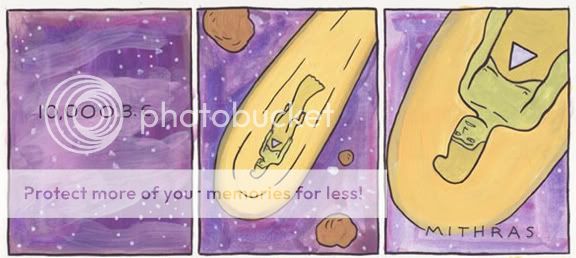
Forming
Jesse Moynihan, writer/artist
ongoing webcomic, January 2009-January 2010 (and counting)
I was pretty happy with the high concept I came up with for Afrodisiac, so let’s try it again: What if the stars of Anders Nilsen’s Big Questions were the Big Answers? Like Nilsen’s funny-animal epic, Forming tells the tale of characters struggling with the stuff of existence–life, death, fate, their place in a universe that appears fundamentally capricious. Unlike Nilsen’s birds, though, Moynihan’s characters are archangels, cosmically powered alien beings, demigods and titans of legend, founding members of humanity who commune (and copulate) with higher beings on a daily basis. The metaphor scales our human plight up, not down, in other words. The art follows suit. Moynihan’s line is soft, its weight gently fluctuating, shored up by quietly irregular coloring, suggesting the same vulnerabilities as Nilsen’s stippling and figurework. But the design is maximalist: Crazy Kirbyesque costumes, Fletcher Hanks psychedelic action, long sequences of physical combat, extradimensional travel, mental fantasias. The stakes are similarly higher–the central action includes Lucifer’s battle with Michael and the birth of human civilization as conferred upon us by ancient astronauts. The gag, of course, is that these highfalutin’ types are just as messed up as we are, complaining about their jobs and their family and their sex lives and so on.
So yeah, you’ve seen it before. But what makes its use in Forming so appealing is the strip’s rolling, loping, laconic pace. New subplots–a literal clash of the titans, Lucifer & Michael, Adam & Eve, corporate intrigue on the alien homeworld–are slowly folded into the strip, and our lens on the action swings back and forth between them like a pendulum. Moreover, most of the strip’s two-page installments are stacked on top of each other, our eyes slowly cascading downward as the action unfolds over a long vertical plane. The cumulative effect does even more than the specifics of the dialogue in terms of humanizing the cosmic characters and wringing bleak gallows humor from their dilemmas. If this thing ever gets collected in print, I’d love to see it in a super-tall, super-narrow format just for that reason. It’s a very pleasurable reading experience, and it’s easy to see how rewarding a weekly visit could be.
Carnival of souls
January 15, 2010* Today at Robot 6: Tom Brevoort, the Lord Emperor of Twitter, talks about the Siege/Blackest Night trade-in offer and Neil Gaiman’s Marvelman plans.
* Brendan McCarthy’s Spider-Man: Fever arrives this April. GLO-FI AS FUCK
* I only skimmed it since I haven’t seen the movie yet, but CRwM’s piece on Park Chan-wook’s vampire film Thirst takes some provocative shots at the horror blogosphere. Sample quote:
This is why the general mediocrity of the Great Zombie Revival is actually the key to its success: A subgenre that reinvents itself in mind-blowing ways every two or three films is going to exhaust the mental bandwidth of its audience as well as sow some discord among people who latch on some particular configuration of the genre elements and decide to become purists. But a certain pandering familiarity, spiced with only slight hints of novelty, neither taxes your audience nor risks alienating them.
I skipped Thirst because I thought it was directed by the guy who did The Host, which was a piece of shit, so that’s my bad.
* Matthias Wivel, Tucker Stone, and Noah Berlatsky explain their choices for the Best Online Comics Criticism of 2009. I recommend Matthias’s and Tucker’s posts, but not Noah’s, since he thinks Ganges is boring.
Comics Time: What Had Happened Was…
January 15, 2010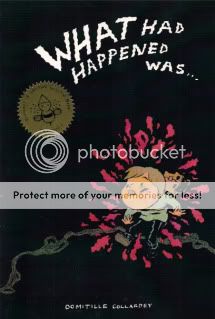
What Had Happened Was…
Domitille Collardey, writer/artist
Weeping Willow, 2009
20 pages
$6
Buy it from Domatille Collardey
You could rough this one up pretty bad if you wanted–like Jog says, it’s an alternative comic of the “here’s some stuff that happened” school that people who dislike alternative comics think all alternative comics attend. Collardey’s stories–actually, that’s too strong a word–reminiscences about her move to Brooklyn, her visit to San Francisco, her interview with Francoise Mouly, her conversation with her Holocaust-survivor grandfather, even her very life story aren’t revelatory, or (with one obvious aforementioned exception) even memorable on their own terms. What they are is a showcase for her art, and she’s got some serious chops. I’m really drawn to her wavy line, the way a series of gentle S-curves both cohere into little people and convey the timidity and uncertainty with which Collardey apparently approaches the world. Against that backdrop her depiction of Mouly really pops: Bigger eyes rimmed with make-up, darker hair, taller body, confidence and competence standing out amid Collardey’s gee-shucks artistic personality. Equally impressive are color sequences that employ brown and gray watercolors to convey warmth rather than desolation or “realism,” most notably in a self-portait that strikes me as both clear-eyed and flattering–which is then surrounded by a colorful panoply of cartoon heads. The paper stock really holds Collardey’s brushwork and colors well, by the way. As a sampler of an artist with a lot of potential, it’s worth a glimpse. Let’s see where she goes from here.
Carnival of souls
January 14, 2010* Dannie Flesher, cofounder of Wax Trax! Records, has died at age 58. I really would not be the same without him. When I was a teenager, the industrial aesthetic pioneered by Flesher, his partner Jim Nash, and Wax Trax! acts like Ministry, KMFDM, and their myriad side projects defined “cool” for me in a way that still holds true for me today. Trent Reznor and Al Jourgensen joining forces to cover Black Sabbath with 1000 Homo DJs’ “Supernaut” is pretty much the most amazing thing a 16-year-old Sean could imagine. Any day I’m dressed all in black, which is usually three or four days a week, you pretty much have them to thank. Today I’m still impressed by just how committed Wax Trax! bands were to their sound and style. There’s a totality to their encapsulation of deviance and decay that’s still chilling, and extremely edgy and ballsy even now. Plus, a vintage Ministry side project is a joy forever–I listened to the Revolting Cocks Beers Steers & Queers just this morning, not knowing what had happened, and it’s still a death-disco hoot. Thank you, Dannie. I hope wherever you are now, Jim’s there with you.
* Today on Robot 6: Buy Prison Pit pages and check out the Best of 2009 comics meta-list, plus a quick thought from me on same.
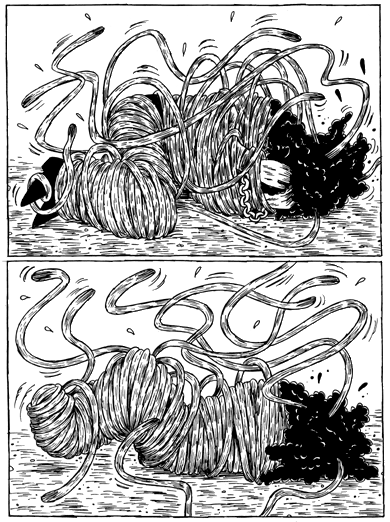
* Hey, new Paul Hornschemeier Forlorn Funnies? How about that!
* Jesse Reese of Are You a Serious Comic Book Reader? tackles Mike Mignola and Richard Corben’s Hellboy: Bride of Hell. The Hellboy books proper spent some time in the wilderness, but I think with The Wild Hunt and Bride of Hell, they’ve been duly and deftly brought in line with what makes B.P.R.D. so compelling: Their heroism ultimately futile, our heroes fail.
* Viz has some cool-looking comics coming out soon.
* Here’s a list of the bestselling graphic novels at my LCS, the great Jim Hanley’s Universe, in 2009. Superhero-heavy, but which superhero titles we’re talking about is kind of surprising.
* Benjamin A. Shobert of Asia Times waxes philosophical about the Red Dawn remake, in which Red China is apparently the heavy. (Via CRwM.)

* Clive Barker is making some fucked-up Halloween costumes.

* Thanks to Tom Spurgeon for directing me to Michael Wm. Kaluta’s J.R.R. Tolkien calendar and a terrifically choreographed Buz Sawyer chase sequence. Next time you just wanna take your superheroes and have ’em fly around shooting shit at each other, please take a look at this and think again!
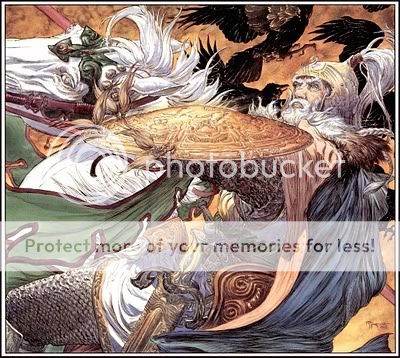
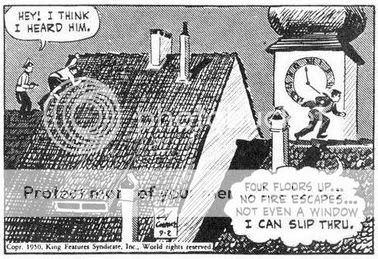
Carnival of souls
January 13, 2010* Hey, it’s a new comic I wrote! Well, it’s actually not new, but it may be new to you and it’s certainly new to the Top Shelf 2.0 site. It’s “Pornography,” a non-pornographic comic written by me and drawn by the great Matt Wiegle. I hope you enjoy it.
* The League of Tana Tea Drinkers horror-blog collective is tackling horror comics. Click the link for further linkage.
* Poe-etic creepiness from Mr. Noel Freibert.
* Solid observation by Tom Spurgeon regarding the December 2009 Direct Market sales charts:
I personally think it worrisome that there’s a drift downwards in books that sell over 50,000 copies, which would seem to support a theory — or late-night, drunken blurting-out, as you will — that a lot of effort is necessary to push certain comics into respectable sales territory and that maybe nothing is being done or can be done for the bulk of them. The comic book middle class is rotting away, in other words. One might suggest that the more poignant outcome of “event fatigue” isn’t that people are going to get tired of events eventually (even though they likely will), but that people are only excited by events now and fatigued by everything else as a result.
* Curt Purcell kicks off a series on Final Crisis by labeling its use of Modernist techniques self-defeating–an anti-story movement welded to a celebration of stories and storytelling. There’s a lot to disagree with here, from the characterization of Morrison to the characterization of Modernism, but I wanna see where we’re headed first.
* The latest What The–?! video is a parody of Dark Reign. The stuff I didn’t write made me laugh.
Comics Time: Afrodisiac
January 13, 2010
Afrodisiac
Jim Rugg & Brian Maruca, writers
Jim Rugg, artist
AdHouse, January 2010
96 pages, hardcover
$14.95
What If Pim & Francie Got Bitten by a Radioactive Luke Cage? Afrodisiac, like Al Columbia’s fractured masterpiece, is a comic, an art book, an objet d’art, an assemblage of stories and story fragments and illustrations and pastiches and sketches and ephemera and so on. Yet I’m guess everyone interested in an Afrodisiac book would have been perfectly happy with an anthology of straightforward blaxploitation riffs, showcasing the heavy-lidded, angular action characters, juicy design choices (this thing is like sound-effect lettering porn), and deadpan over-the-topness we saw from the Rugg & Maruca team in Street Angel, maybe with a few ben-day-dot nods in the direction of faux vintage. So why go further? Well, for one thing, if you have the design talent that Rugg and Chris Pitzer do, why not.
But what these moves communicate is the slipperiness of what Afrodisiac really is. The titular hero receives a different origin with each story–he’s a cyborg, an inner-city Billy Batson, a ghetto Captain America or Thor or Spider-Man. He’s marched through a variety of comic-genre parodies–Archie, romance, funny-animal, Bronze Age Marvel magazines, Bronze Age Marvel comics. Sometimes his adventures are made to look like they could have sprung straight from the ’70s, but other times the coloring or the printing or the language (this ain’t Comic Code approved!) tip the project’s hand. And that’s to say nothing of Rugg’s art, which is sly and slick in a fashion that befits a guy who gets into the annual Society of Illustrators show every year rather than a member of the Gerry Conway-era bullpen. And have we ever lived in a world where a character like the Afrodisiac would get a toy line or a Saturday morning cartoon?
It could have simply coasted on the asskicking concept of a superhero pimp called the Afrodisiac, but every choice Rugg, Maruca, and Pitzer make here makes it harder to put your finger on what’s going on. Which, I think, is the point: Afrodisiac is an attempt by modern white nerds to capture and critique the art made by the white nerds of yesteryear’s attempts to capture the art made for that era’s black audiences in response to what that era’s white entertainment industry thought of that era’s black audiences, specifically what they wanted to see from the relationship between black criminals and white women. (Phew.) It is, in other words, about the nature of truth, about different marginal or marginalized subculture’s attempts to understand and interact with one another, how those attempts magnify and distort one another, and in the end produce art as fascinating and fractured and entertaining and incomplete as the cut-up “final issue” that ends the collection. Powerful stuff? You’re damn right.
Carnival of souls
January 12, 2010* Chew on some good online comics criticism courtesy of a blue-ribbon panel hosted by Ng Suat Tong, and swing by panelist Frank Santoro’s place for further options.
* The latest stop in The Cool Kids Table’s journey through the decade in comics is 2006, aka The Year of 52.
* Buffygate has been pretty entertaining. I like to imagine Whedon wading in, tossing Bill Willingham’s ruined body onto the floor, and saying “What we have here is failure to communicate.”
* What if Clowes was one of us? He was young like one of us?
* Thank goodness for all those giant Stone Age bats, or else how the heck would Bruce Wayne maintain his signature look?
Carnival of souls
January 11, 2010* Tom Spurgeon ends his holiday interview series with a bang: Bill Kartalopolous on Kramers Ergot 4. I find the way he situates the book in terms of previous publishing efforts by Jordan Crane and Tom Devlin really welcome, since that’s the environment in which I was approaching the book at the time. It’s also worth comparing his experience with Kramers and Blankets at MoCCA 2003 to mine.
* And with that, the holiday interview series draws to a close. Thanks, Tom, I know I’m biased since I was involved, but I enjoyed it as much as any online comics writing I’ve come across in a long time. Here’s a wrap-up/round-up/highlight reel.
* Today on Robot 6: Lots and lots of little announcements regarding Brightest Day, DC’s post-Blackest Night event/series/brand. The most interesting to me is the biweekly series of the same name by Geoff Johns and Peter J. Tomasi.
* Related: a very nerdy Geoff Johns Q&A. (Is there any other kind?)
* Also related: Curt Purcell on stories vs. events.
* Back on Robot 6: read Dan Hipp’s cool-looking series Gyakushu! online for free, and John Malkovich is the Vulture. (Except that, uh, the whole thing has been scrapped–good, maybe we can get a good Spider-Man movie now.)
* I fully support 3D re-releases of the Star Wars and Lord of the Rings movies. But is it really true that “Experts now predict that 3-D will become the new multiplex standard within five years” in “as dramatic a shift as when the ‘talkies’ killed off silent movies in the early 20th century”? Also, do you really need to grant anonymity to a source when all they’re saying is that George Lucas is excited to tinker with his old movies using new technology? Oh well.
* Matt Maxwell continues mulling over horror, science fiction, and issues of story scale. He’s also posted all of his “Conversation Fear” columns from the late, lamented Dark But Shining horror blog.
Comics Time: Sleeper Car
January 11, 2010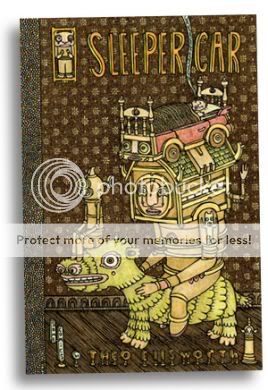
Sleeper Car
Theo Ellsworth, writer/artist
Secret Acres, 2009
32 pages
$6
Theo Ellsworth’s Capacity, a monumental work of ferocious interiority combined with irresistible openness, was one of the decade’s best comic debuts. It was a knockout. Sleeper Car is more like a playful tweak of the nose or pat on the buttcheek. Stepping away from the artistic-autobiography subgenre that made Capacity so singular, Ellsworth uses this 32-page pamphlet as an opportunity to deploy the same tools he used there–the endlessly inventive character designs, the googly eyes and rubber lips, the enveloping crosshatched backgrounds, the seemingly infinite fur and feathers and scales and joints and so on–in the service of what I think could best be called flights of fancy. The stories and strips here are funny, though they’re not out and out gag comics; they’re fantastical, though they’re too loose and unconcerned with narrative worldbuilding to qualify as fantasy. What’s interesting to me is seeing the different approaches he takes with each one.
For example, the longest, central story, about two verbosely formal robots who make a bet about the existence of gnomes, uses a staid six-panel grid to heighten its deadpan humor. But the source of that humor shifts throughout–first it revolves around the wordplay of the droids’ creaky way of speaking, then gets goofy showing the second robot passing the time as the first embarks on his search for proof, then there’s a series of very funny “photos” of the victorious robot’s shenanigans with the loser’s forfeited arm, and then there’s a punchline splash page (!) that injects a whole new comical menace into the proceedings. Throughout, it’s all about knowing just what image will nail the required effect. You see this in many of the strips here: A traveler’s wanderlust depicted by showing him distraught and on skis at the top of his staircase, say, or a sleeping behemoth scratching his head in wonderment as an explorer rockets out of his gullet, or a kid’s eyes peering from the distended neckhole of his pajama shirt as he wraps up his knees, feet, and arms in it to form a “pajama tent,” or a drawing of empty bus stop letting us down easy after a strip in which a traveler’s face transformed wildly from panel to panel. None of it’s gonna bowl you over, but none of it’s meant to. It’s expert, effective cartooning–little sketches of where a cartoonist with this visual vocabulary and this set of ideas can go. I’ll follow him there, that’s for sure.
Carnival of souls
January 8, 2010* Matt Maxwell asks, in essence, does that which is horror in micro become science fiction in macro? Really good question, Matt. Brainwave: Thinking about it with this in mind, I think what sticks with me about Cloverfield is that it goes macro but yet it still feels “horror” to me. Perhaps this is a specific feature of Lovecraftian horror?
* My wife showed me a clip from Human Centipede on YouTube and I was beyond disturbed. I can’t remember the last time I had that visceral a reaction to something that wasn’t one of my usual triggers, like growths or animal cruelty. Anyway, IFC will be distributing Human Centipede in the US.
* Jesus, look at this Jim Blanchard drawing of Ian Curtis. The larger version, available at the link, is now my desktop wallpaper. (Via Flog.)

* Today at Robot 6: New Iron Man armor and a shopper’s guide to the Fantagraphics New Year’s Hangover Sale.
* A short but sweet chat between Tom Spurgeon and Dan Nadel about Joan Reidy & Ron Rege Jr.’s flawless Boys.
Comics Time: Monsters
January 8, 2010
Monsters
Ken Dahl, writer/artist
Secret Acres, 2009
208 pages
$18
Gross-out sex-life autobiography has a storied history in alternative comics, but it’s sort of a St. Olaf story. (Crumb is repeated first as tragedy, than as farce.) Folks with sufficient cartooning chops are afforded ample opportunity to Tex Avery themselves out, which I do appreciate. And of course there’s the thrill we get from coming across someone with no internal censor–to paraphrase Hesh Rabkin, between their brain and their pen, they have no interlocutor. But it’s very, very, very well-trod territory, and you can count me among the people who came across Joe Matt’s Spent and thought “Well, that’s enough of that.”
So it took some persuading for me to give Ken Dahl’s Monsters the story of his life with herpes, a shot. Another comic about some creepy artist type’s loathsome behavior around and toward women? Drawn with confrontationally ugly underground-style depictions of everyone involved and hyperactive exclamation-point-ridden lettering? Coupled with enough grand-guignol lesion close-ups to trigger my skin-growth phobia like wo?
Wrong wrong wrong! I enjoyed the heck out of this book. For starters, I was giving Dahl’s art short shrift. Jeepers this guy is accomplished. I don’t point this out nearly often enough, but as a non-artist, I really get a thrill out of good cartooning because it’s so beyond my ken. To develop a visual vocabulary and deploy it consistently page after page…I mean, man. Anyway, on the most basic level, Dahl’s bobble-headed, adenoidal characters are crafted with an assured, flowing line that trails off into feathering wisps for a hint of vulnerability beneath the slickness. Moreover, they are an instant visual signature, serving both to deflate the angst and self-absorption of his story and satirically skewer the various alt lifestyles of which he is a tangential part. (For what it’s worth, I think the mockery–of everyone from Christians to vegans–is one of the less considered parts of the book, but still, no one comes out of this looking like an angel.) But more importantly for the book, they’re a template from which he can deviate for extravagant, almost Tom Neely-esque sequences, in which Dahl’s emotions and/or his infection literally explode from within and take over in monstrous fashion.
But for me, the most interesting thing about Monsters is Dahl himself. Turns out he’s not a creep at all! He has no idea how he got herpes, had no idea he had it when he gave it to his girlfriend, and commits a grand total of one genuinely douchebaggish actions in the entire course of the book. Instead, he obsesses on his condition to a psychologically debilitating degree, sealing himself off from having a healthy social life or any kind of romantic relationship for years. In fact, while the “educational filmstrip” facts’n’figures sequence about herpes simplex is the book’s ostensible centerpiece, for me the real tour de force was the ending, which in a quick one-two punch upends what I’d thought was going on with both the story’s plot and its moral. Dahl turns out to be far more victim than victimizer, and the deft way in which he teases that reversal out of our expectations for a book of this sort is its best trick.
Carnival of souls
January 7, 2010* By far my favorite set of responses to Heidi MacDonald’s end-of-year/decade survey comes from Sparkplug’s Shannon O’Leary, and not just because she’s a rare voice of sanity regarding Battlestar Galactica‘s breathtaking finale. O’Leary digs in and unpacks the fallout from Diamond’s decision to raise its order minimums in such a way as to essentially extinguish the presence of the small press in the Direct Market. I’m grateful, because it was only after reading Heidi’s survey that I realized I’d all but forgotten that this even happened–that’s how quickly and totally I internalized the notion that unless you’re a really lucky person in a big city or college town, you can’t get those comics in comic shops anymore, it’s just a given. That’s your story of the year, I’d say, much more so than the big moves at Disney/Marvel and Warner/DC, where very little has happened yet and I imagine the main effect will be to cut out some ingrained nonsense.
* What’s more, Diamond’s move has made Internet retail presences, webcomic set-ups, small-press shows, and small-press-friendly websites all the more important to an entire mode of expression. Case in point–I’m not sure you’d be seeing so many excellent altcomix, like this little number from Frank Santoro, online these days if the DM were still open to it at all. The move has made Internet retail presences, webcomic set-ups, small-press shows, and small-press-friendly websites all the more important to an entire mode of expression.
* What I’m most concerned about in 2010 is how Diamond, the economy, and the short-term-profit-maximizing policies of the big companies will jointly shape the fates of the ’00’s new breed of publishers. Bodega’s already taking the year off; whither Buenaventura, PictureBox, Sparkplug, Secret Acres, AdHouse?
* Today on Robot 6: Michael Kupperman’s rejected New Yorker comics and Matt Groening’s music festival.
* I have no brief with Ti West’s The House of the Devil, but releasing a VHS version as a promo item is a great idea, and its mimicry of vintage ’80s VHS packaging is impeccable, as any Portable Grindhouse owner could tell you. It’s the back cover that really gets it over.
* The Sinestro Corps War really was very well done. And it pulled Curt Purcell back from the brink!
Carnival of souls
January 6, 2010* Ben Schwartz and Tom Spurgeon talk B.P.R.D., the best ongoing superhero comic of the decade. It’s a rambly thing that talks as much about Otto Binder and Alan Moore as it does about Hellboy, but you won’t mind much. What’s fascinating to me is that Schwartz got into the series as recently as the Black Goddess arc, which was the most recent one (until today’s release of King of Fear #1). I played catch-up with Hellboy in, oh, 2002? 2003? and then started following all the Hellboy-verse books from there, so it’s interesting to see the impact they can have on someone who reads a big chunk in a short time frame. After all, it’s been telling one large story since Davis and Arcudi came aboard, so it’s probably like plowing through an HBO show on DVD. Two things I wish they’d gotten to are 1) the degree to which both BPRD and Hellboy have become about the characters’ failure to do what they’re trying to do, and 2) that wonderful scene in The Black Flame where the evil CEO enters his boardroom in full flaming-skull supervillain regalia and calmly tells the board of directors “You’re all fired”–one of my all-time favorite comics sequences, up there with the end of the World’s Fair issue of ACME, the beach scene in Diary of a Teenage Girl, the locust sequence in Skyscrapers of the Midwest, the lizard-tail sex scene in Black Hole… Also, Tom, I don’t suppose Ben convinced you to count B.P.R.D. and Hellboy (and The League of Extraordinary Gentlemen) as superhero comics for your best-of-the-decade shortlists, did he?
* A Masters of the Universe art show? Oh, indeed. The world of He-Man is deathlessly weird, an everything-and-the-kitchen-sink amalgam of stuff that’s cool to eight year olds. It’s the closest this country’s come to the bizarre childhood entertainment franchises of Japan, I would say. (Via FarePlay.)
* Three things that are cool-looking enough that I’m not even going to show you a sample image, you’ll just have to click for yourselves: Kevin Huizenga’s “Famous Ghost,” Josh Cotter’s Xmas commission, and Tom Neely’s “I just figured it all out…”
* Matt Maxwell’s latest decade-in-review installment tackles the history of his reading and writing about comics. I’m second only perhaps to Heidi MacDonald in getting a kick out of trips down comics-blogosphere memory lane.
* Poor Curt Purcell. Curt, if I’d known you’d gone into your project of reading each and every event-comic tie-in title actually expecting to be entertained more often than not, I could have warned you, like the wizened old local at the end of the first reel of a horror movie.
* Rob Bricken’s review of Avatar makes me feel like maybe he and I linked up the neurons in our respective headtails. Now we’re bonded for life.
* Only problem is that I’m clearly already ponytail-to-ponytail with Tucker Stone, if his Best Comics of 2009 list is any indication. Sample quote: “There’s scary, and then there’s horrifying. After reading Cockbone, I’m starting to wonder if there’s a third thing that’s even worse.”
Comics Time: Giraffes in My Hair: A Rock ‘n’ Roll Life
January 6, 2010
Giraffes in My Hair: A Rock ‘n’ Roll Life
Bruce Paley, writer
Carol Swain, artist
Fantagraphics, 2009
136 pages, hardcover
$19.99
Pencil is not an easy medium to publish in for a cartoonist–just ask the superhero artists whose work looks like the proverbial cake left out in the rain when “digitally inked” or colored right off the original pencils. But Carol Swain makes it look easy, and I think it’s because she’s figured out a way to spot blacks with a pencil. Those sooty shadows and clouds and night skies and manes of wild hair suffuse her work in Giraffes in My Hair with a sort of negative-image glow, popping her foregrounded figures off the page with a barely-there white aura. Couple it with her ever-shifting angles and it’s a damned effective way to create a sense of space and depth, reminiscent of similarly adroit strategies by Jeffrey Brown and Ben Katchor. If Swain’s jarring close-ups make her panels less immersive than theirs, her porous gray shadings make up for it with atmosphere–an inviting softness, tinged with just enough smokiness to remind us that what’s going on here isn’t entirely pleasant. The overall effect works so well that I really had to stop myself and peer at her pages to figure out what made them tick. I was too busy being propelled along by the effortlessness of the art.
So Giraffes, a collection of anecdotes from Bruce Paley’s teens and twenties on America’s countercultural fringe, is a breezy read. But it’s one rooted in an almost unchanging nine-panel grid with sparse, nearly monotone narration. At times this allows the comics to tip over into bluntness, particularly with the ending to some of the stories: The tale of how Paley avoided Vietnam ends with a shot of the Wall; a story of New York City’s ’70s heroin scene ends with Death itself offering us a bag of smack. But in general, the art and the writing are a perfect fit. Swain’s art rarely calls attention to or gets in the way of itself, and in that it meshes seamlessly with Paley’s deadpan “here’s what happened” narrative style, his reluctance to overstate or oversell the import of the anecdote reminiscent of Harvey Pekar’s. (Of course, Pekar’s work rises and falls on the strength of his collaborators–Paley’s got Swain, so there’s not much falling to do here.)
Yet at the same time the presence of that subtitle indicates a unifying theme, which makes Paley’s storytelling choices all the more interesting. The first story shows an 18-year-old Paley ditching college and leaving home to hitchhike cross-country with his girlfriend, but the home life that led him to drop everything and drop out is relegated to a quick line of dialogue and about half a page upon his return from the journey. As hippies give way to punks we suddenly discover that Paley’s a habitual heroin user, but we never see his introduction to the drug. A story about an ill-fated attempt to import drugs from overseas sees Paley casually mention time spent in Tangiers, but up until that point his adventures had been strictly domestic. In some graphic memoirs these lacunae would be maddening; here’s they’re sort of the point.
Paley’s not claiming anything spectacular about the life he lived or the stories he plucked from it. The way he tells it and Swain draws it, living on the edge feels like an interchangeable commodity with Pekar’s life as a civil servant. An interesting conversation with the janitor may be replaced by doing speedballs with Johnny Thunders, but the game’s the same: get by, find a little happiness when you can, and cling to the stories that comprise your life, the recounting of which has a value all its own.
Carnival of souls
January 5, 2010* Wow, this is really something: Like half the cast and writing staff of Saturday Night Live is doing a fundraiser for the off-Broadway adaptation of Phoebe Gloeckner’s The Diary of a Teenage Girl. Money well spent for a variety of reasons.
* Powr Masters 3 and If ‘n Oof: on the way in May!
* Over at Robot 6 I rounded up some notable posts in the great “Did comics stink in 2009 or is it just me?” debate.
* Tom Spurgeon interviews Jog on Death Note, one of the great entertainments of the comics decade.
I’m blue, dabba dee daboo die
January 5, 2010Avatar is a so-so movie that I highly recommend you see in as big and expensive theater as possible. My evening at Avatar cost me in the neighborhood of $30 all told, and had to be scheduled half a week in advance, like an in-demand local theater production or something. I do feel like I got my money’s worth, even though everything that everyone says about the movie is 100% true. It’s a deeply impressive visual experience tied to a deeply pedestrian script. But you don’t ride the Cyclone for the character arcs, do you? Seeing the movie in 3D on the biggest IMAX screen in New York State that isn’t for a museum seems to me the ideal way to see it. So yeah, thirty bucks well spent. Even though I very much doubt I’d even want to watch it on a television. Because here’s the problem: It’s only ever good enough.
The one thing it does inarguably well is take advantage of the 3D canvas to work with vertical scale. Worm’s-eye and bird’s-eye shots of the kind of landscapes that would simply boggle your mind were they real abound–you peer up and down floating mountains thousands of feet in the sky, you get a view of a tree the size of the Sears Tower. Fantasy and fantastic fiction generally sorely need to use their Y-axis, and Cameron gets that right, no doubt. It’s obviously the perfect use of his genuinely fantastic 3D technology. You’re not getting shit flung in your face, you’re not simulating an amusement-park ride, you’re as close to being in there, or up there, or down there, or out there, or whatever, as movies can get.
But. While they’re not as obnoxious and ridiculous as you probably thought they were when you first laid eyes on them after all the hype, those blue alien designs really are dullsville. Smurf Gollum Jar-Jar Omaha the Cat Dancer people in loincloths and dreadlocks with your basic “here’s what James Cameron synthesized from reading about tribal customs” worldbuilding undergirding them. That’s all.
(Regarding a related issue, I’m not the kind of person who’s easily offended by the supposed racial overtones of fictional races. The Gungans didn’t bother me, and neither did the Orcs. Of course, in neither of those cases did the storyline hinge on the kind of racial dynamic we’ve actually seen here in real life, with white dudes coming in and knocking an indigenous people out the box to steal their land and resources. Even still, aside from a slightly cringeworthy bit where everyone gawked at the newcomer and some silly hula-hula dancing, it didn’t really rub me the wrong way. I mean, it’s too rote to be upsetting.)
I’d been similarly skeptical about the creature designs–they all just looked like a mess of colors and limbs with very little thought to how they’d actually evolve and function. Seeing them in action makes them a lot more persuasive–nearly all the lifeforms we see, the fauna at least, look and feel like they’re part of a consistent ecosystem. Even there, though, I was frustrated by the lack of imagination. There’s a monkey species, a lion species, a dog species (that barks!), a horse species (that our main character, Jake Sully, actually calls horses!), and then some dinosaurs. The dinosaurs are my favorites, you can get away with dinosaurs, but I couldn’t help but feel like they could have done better with the rest. Meanwhile–prepare for geekiness–all of the animals have six limbs, except the Na’vi, the humanoids we’re involved with here. Are they supposed to be on an entirely separate evolutionary chain? I don’t think so–if the six-limbed monkeys, ostensibly the world’s equivalent of the primates several limbs over from us here on Earth, weren’t enough of a clue, the plotline about the interconnectedness of all life on the planet would argue against it. So you’re left drawing the conclusion that they have four limbs because it’s easier that way.
It’s sort of unfair to compare the movie to The Lord of the Rings, in that Tolkien had one of the most unique minds in literary history while James Cameron, um, doesn’t. But when you look at Peter Jackson’s film adaptations, which share with Avatar the same special effects team, you can see how weak and doughy the world of Pandora is compared to the world of Middle-earth. Watching the behind-the-scenes material on the LOTR DVDs, you see time and again Peter Jackson rejecting sketches and designs for the various creatures that inhabit that world because they’re too fanciful, they wouldn’t work. No such guiding intelligence was at the helm here, so bring on the six-winged four-eyed rainbow dinosaurs.
Alright, to heck with it, let’s compare it to Lord of the Rings. The reason those movies succeed so well as action cinema is because all the combat is so rooted in a sense of location and direction. I could sit here and describe to you the Battle of Helm’s Deep like I was transcribing it from the screen, that’s how well delineated each state of the fighting is and how clear the consequences for each major turning point are. The same is true of the attack of the Uruk-Hai at the end of Fellowship, and even the wide-open Battle of the Pelennor Fields in Return of the King. When the Rohirrim reform the line and charge the Haradrim, it’s crystal clear what’s happening and why. (The one exception in all three films is the warg fight, for which they just didn’t have time to devise an intricate fight plan, and for which they apologize on the commentary track–but since it’s the exception, that chaotic lack of choreography ends up working for it. It stands out as a frantic, nasty battle.) With Avatar you just have a bunch of swooping and charging. There’s the slightest nod to taking advantage of positioning at the very beginning of the climactic battle, and then it’s all flying around and running around and shooting around. And there’s a big ground charge where I kept waiting for what the trick or surprise would be, but was shocked to discover that there wasn’t one. It’s exactly what it looked like it would be. It’s frustrating, because think of Aliens or Terminator 2–Cameron once knew how to stage action within a visually described environment. Here he seems to be hoping the 3D will do the trick for us. It doesn’t.
Then there’s the writing. Over the past few days I’ve given some thought to how important it is to care about, flesh out, and even empathize with your villains. This is because I’m a couple eps deep into season two of True Blood, and there’s a storyline involving an evangelical megachurch pastiche that is just sooooooo boring, because you can tell that everyone involved with the show bleeds with contempt for these people and has no interest in making them interesting, appealing, or sympathetic. They’re just cardboard cutouts. They’re called The Fellowship of the Sun, which is funny, because the last time I saw TV antagonists this dull and this much a waste of my time they were called the Baltimore Sun and I was watching The Wire Season Five. Vampires and drug kingpins who’ve murdered dozens of people were painted in a much more sympathetic, and not coincidentally alluring and compelling, light than some asshole godbotherers and hack editors respectively. If the filmmakers don’t care enough to even try, why should I?
I’m almost tempted to say this about Avatar, in which the military guns-for-hire who evolve into the movie’s villains are just a faceless bunch of rapacious barbarians led by General Goony McGoonerson. One-dimensional barely cuts it. But it’s hard to get too worked up, because there’s really nothing going on with any of these characters. Everyone zigs when you expect them to zig, zags when the plot needs them to zag. People have the changes of heart you expect them to, make the heroic sacrifices you expect them to, misunderstand what you expect them to and then overcome those misunderstandings when you expect them to. Never once did I feel any attachment to anyone in the movie, or any investment in their fate, beyond whatever lizard-brain response run-of-the-mill “good vs. evil/underdog vs. empire” conflicts can muster.
The one surprise is just what a full-throated endorsement of treason the movie ends up being, and how full of visceral hatred it is for the despoiling of the environment and the invasion of small countries by big countries. I got a big kick out of all of that–it was so in-your-face it was admirable–but not enough to overcome how well it paid to expect the expected from the rest of the flick. Also, we’ve been there once before with Paul Reiser, who was funnier and sleazier and tougher to predict.
And there’s more, of course: plot holes regarding the escape of our heroes from captivity, a boring score (dammit I am so sick of that), shots that stunned but never seduced (I counted three what I would call “visually poetic” shots or cuts in the entire film–lots of gosh-wow, very little damn). On the other hand I never got bored, which given its running time and predictability was definitely a peril–it does draw you in, and I didn’t even get up to use the bathroom. Like I said, it was a good way to spend my time and money, a fun film, a demonstration of what someone with Cameron’s budget and all the CGI and 3D tech now at filmmakers’ disposal can do. I just can’t wait for someone to actually do it.
Carnival of souls
January 4, 2010* Robot Roll Call! Here’s a round-up post I did featuring links to everything that went up during Robot 6’s big anniversary weekend. Lots and lots and lots of cool content, something for everyone I daresay.
* My favorite of the bunch is our list of The 30 Most Important Comics of the Decade. Part One I already mentioned; Part Two contains my write-ups for The Complete Peanuts, Kramers Ergot, Art Out of Time, Daredevil, and Blankets–all in a row! But you’ll have to click to see where they all fell on the countdown. And check the comment thread for a “editorial cartoons aren’t comics” argument preserved in amber from the McCloudian past like one of those Jurassic Park mosquitos.
* I greatly enjoyed Douglas Wolk’s conversation with Tom Spurgeon about Invincible Iron Man. It really is a conversation, and that’s what makes it one of my favorite pieces in Tom’s holiday interview series on the books of the decade thus far. To paraphrase what Tori Amos’s Jungian mystic once said about me and my wife, the rocks in Tom’s head fit the holes in Douglas’s.
* Here’s another post I cheered for: David Uzumeri’s look back on 2009, by way of responding to the oft-advanced notion that the year really uniquely sucked for comics and/or superhero comics. He just piles up evidence for the case against. On a related note, Jeff Lester did a bang-up job with his post on the origin of comics burnout.
* The thing I loved about Jog’s Best of 2009 post is that he spends as much time talking about the books he missed as he does the books he loved. A great idea! You get almost as much of a picture of the state of the art from the former as you do from the latter. The thing that bummed me out about the post is that two of his top five were books I haven’t even read (through no lack of trying on my end, in my defense), meaning my own list is probably a big lo’ shit sandwich.
* Elsewhere, Jog and I have a quick back-and-forth about our differing reactions to the differing works of Naoki Urasawa.
* MOAR DECADE IN REVIEW FROM MATT MAXWELL
* Yep, I’m gonna have to see Pontypool.

* If you’re looking for good music you haven’t heard, you could do a lot worse than to download Matthew Perpetua’s “Lost ’00s” mix, featuring gems that were largely overlooked over the past 10 years. You really can’t go wrong with Muscles and In Flagranti, I can tell you that much. I’ll tell you what, it’s a bit of a bummer that I’ve become friends with Matthew, because for years he was my source for music I could impress my friends with that no one else had ever heard of, but what the hell can I impress him with? My extensive Pigface collection? (It’s pretty impressive.)
Comics Time: Big Questions #13: A House That Floats
January 4, 2010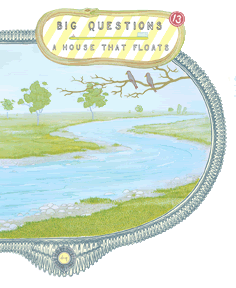
Big Questions #13: A House That Floats
Anders Nilsen, writer/artist
Drawn & Quarterly, 2009
44 pages
$9.95
My sincere hope is that a couple years from now the collected Big Questions will lodge itself at the top of future Best of the Decade lists on the strength of material largely published the previous decade, like Jimmy Corrigan and Black Hole before it. Certainly Nilsen is a capital-M Major Talent, a real world-beater for his generation, but the book by which he will be defined has not yet been released. The two Monologues for… books from Fantagraphics delight me with their weird existentialist stick-figure stand-up comedy, but talk about an aquired taste. Dogs and Water might pick up steam in the post-The Road world, but it’s always gonna read grim, and its strange release pattern–first as the fattest stapled pamphlet you ever saw, then a slightly revamped version in hardcover–threw folks for a loop. Don’t Go Where I Can’t Follow devastates virtually anyone who reads it, but its hodgepodge hybrid format, arising from its tragic origin as a travelogue-turned-eulogy, makes it a tough item to classify. The End could end up topping my personal Best of the Decade list, but it’s a one-shot Ignatz-format pamphlet. I could see his mythological comics for Kramers Ergot clicking but there’s just not enough of them.
But soon, along will come a thick hardcover of this monumental series, tracing its evolution from xeroxed minicomics sold at a table alongside Jeffrey Brown, John Hankiewicz, and Paul Hornschemeier comics, through its adoption by D&Q, into its status as one of the only regularly released alternative serials in North America. It’s as fragile and frightening as any of Nilsen’s many, many comics about the baffling horror of senseless death, but it’s also a funny-animal book stuffed with subplots and side-stories and borderline gag strips about wisecracking birds. It works as a showcase of pure cartooning as well as even Nilsen’s most abstract, “pure comics” stuff from MOME or The End, but in the service of a sad and searing realism whose beauty is apparent to any reader even remotely open to altcomics work–certainly I’d stack this issue’s cockpit sequence against anything else this year for sheer stunning loveliness. It functions as allegory, but then turns around and acknowledges its own allegorical nature, and ads enough detail and twists to hold up as a real-deal semi-adventure. It manages to capture and cry for the world’s cruelty, yet hold alive the hope offered by cooperation and community and small kindnesses, even those arising from bare enlightened self-interest, as well as anything this side of Deadwood. I laughed, I cried, in the space of this issue alone. Big Questions is a great comic.
Critics Pass Away
January 3, 2010The Ganges material in Tucker Stone’s installment of Tom Spurgeon’s decade-in-review interview series is pretty great. I like all the attention he pays to how the mere size of the page Huizenga’s working with for the Ignatz format gives him latitude he doesn’t have in Or Else or Fight or Run–that’s a pretty terrific point, especially considering how much the Ganges comics depend on reproducing certain effects across the space of the page. Jesus, can you imagine “A Sunset” as appearing in Ganges rather than Or Else? Drooooool
But let’s face it, I came here to kvetch about Tucker’s latest hand-waving about the futility of making value judgments as critics. He responds to Tom Spurgeon’s (accurate) assessment of people who summarily dismiss non-genre comics as “ignorant” by more or less attacking the very idea that anyone should read anything but what they’re already reading, labeling those who’d argue otherwise “boring assholes.” It’s similar to how, during the SPX critcs roundtable, someone mentioned the critical discourse, and he equated it to people on YouTube calling each other cunts.
First of all it dodges Tom’s specific point, which is that it really is ignorant to dismiss comics like Ganges as boring out of hand. Yes, all criticism is subjective, everyone’s coming at everything from different places, but if you can’t say “Ganges isn’t boring,” there’s no point to writing about comics at all. “Comics culture,” as everyone from Wizard to the The Beat to the San Diego Comic Con to me understand it, is “comics plus genre work from other media,” which is an indication of how hard non-genre comics have to fight to gain a foothold. It’s big problem, and Tom’s not wrong for pointing it out.
Secondly, Tucker tries to back up his argument by reversing it, saying it’s just as stupid to harass big Anders Nilsen fans into reading Batman. But that’s a strawman. Can you find anyone (besides maybe Rob Clough and Domingos) who dismisses genre the way so many superhero fans do the reverse, so that you would even have to harass them? Gary Groth loves Jack Kirby, Art Spiegelman wrote a book about Jack Cole, Joe McCulloch has read every Garth Ennis Punisher comic, and Tom Spurgeon has waged years-long campaigns on behalf of the Luna Brothers and Lee/Kirby Thor. On the other hand it’s almost impossible to avoid best-of lists that don’t include anything further afield than Mark Waid’s Irredeemable. It’s a problem in one direction; it’s not a problem in the other direction.
I mean, if you met someone who only watched superhero movies, you’d think that was weird and dumb, and you’d be right, and saying so wouldn’t make you a boring asshole, it’d make you a person who was right. Moreover, saying so does not mean you’ve extrapolated that they’re some horrible CSI Miami-watching mouthbreather or anything else about “who they really are” or whatever. You’re just a critic, addressing what people are saying about specific comics, which is a valid thing for a critic to do.
Finally, Tucker’s coup de grace is the fact that most of the audience doesn’t really care about critics or critical approaches to what they enjoy reading anyway. But so what? Most of the people in the theater with us at Up in the Air yesterday have never read Pauline Kael. But criticism is not therefore an egomaniacal waste of time, any more than making art that most of the audience for that art form doesn’t really care about would be. Kevin Huizenga shouldn’t hang it up just because he’s not Jim Davis; similarly, we shouldn’t crumple up the idea of analyzing art and arguing for standards and throw it in the trash because many people would just rather read/watch/listen and then do something else.
